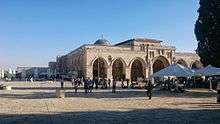Holiest sites in Islam
There are numerous sites in that are considered holy to Islam. Mecca, Medina and Jerusalem are the three holiest cities in Islam, unanimous among all sects.[1]
Hijaz

Mecca
Mecca[2] is considered the holiest city in Islam, as it is home to the Ka‘bah (Arabic: كَـعـبَـة, 'Cube') and Al-Masjid Al-Ḥarām (Arabic: الـمَـسـجِـد الـحَـرَام, "The Place-of-Prostration The Sacred"). Only Muslims are allowed to enter this place.[3]
The area of Mecca, which includes Arafah,[4] Mina and Muzdalifah, is important for the Ḥajj (Arabic: حَـجّ). As one of the Five Pillars of Islam,[5] every adult Muslim who is capable must perform the Hajj at least once in their lifetime.[6] Hajj is one of the largest annual Muslim gatherings in the world, second only to pilgrimages to the Mosques of Imam Husayn and Abbas in Karbala, Iraq, with attendance reaching 3 million in 2012.[7]
Medina
Al-Masjid An-Nabawiyy (Arabic: الـمَـسـجِـد الـنَّـبَـوِيّ, the Prophet's Mosque) is located in Medina, making the city the second-holiest site in Islam, after Mecca. Medina[8][9] is the final place-of-residence of Muhammad, and where his qabr (Arabic: قَـبـر, grave) is located.[1] In addition to the Prophet's Mosque, the city has the Mosques of Qubā’ (Arabic: قُـبَـاء)[10] and Al-Qiblaṫayn (Arabic: الـقِـبـلَـتَـيـن, "The Two Qiblahs").[11]
Shaam

The region of Jerusalem is mentioned in the Quran as being "blessed" and "holy", on numerous occasions, below are Quranic references from Surah Al-Ma'idah (5),[12] Isra (17),[13] Al-Anbiya[14] and Saba (34):[15]
"O my people! Enter the holy land which Allah hath assigned unto you, and turn not back ignominiously, for then will ye be overthrown, to your own ruin."— Qur'an, Surah 5 (Al-Ma'idah), Ayah 21.
"Glorified be He (Allah) Who did take His servant (Muhammad) for a journey by night from Al-Masjidil-Harām to Al-Masjidil-Aqṣā, whose precincts We did bless, in order that We might show him some of our Signs. Verily He is the All Hearing, All Seeing....
If ye did well, ye did well for yourselves; if ye did evil, (ye did it) against yourselves. So when the second of the warnings came to pass, (We permitted your enemies) to disfigure your faces, and to enter the Masjid as they had entered it before, and to visit with destruction all that fell into their power."
— Qur'an, Surah 17 (Al-Isra'), Ayat 1 – 7.
"But we delivered him (Abraham) and Lot, and directed them to the land which we have blessed for the Worlds....
And for Solomon, We subjected the violent (unruly) wind flow (tamely) to his order, to the land which We had blessed: for We do know all things."
— Qur'an, Surah 21 (Al-Anbiya), Ayat 71 – 81.
"Between them (Sabaeans) and the qurā (Arabic: قُـرَى, townships) which We had blessed, We had placed townships in prominent positions, and between them We had appointed stages of journey in due proportion: "Travel therein, secure, by night and by day.""— Qur'an, Surah 34 (Saba), Ayah 18.
Jerusalem
Al-Masjid Al-Aqṣā (Arabic: الـمَـسـجِـد الأَقـصَى, "The Place-of-Prostration The Farthest"), the third holiest site in Islam, is located in Jerusalem. It has a very special place in the hearts of the entire Muslim community, due to its unique and rich history as a place of worship that is so closely intertwined with the lives of many of the Prophets of Islam, as well as for its special status. It is a Mosque comprising 144,000 m2 (1,550,000 sq ft) in size (covering approximately one-sixth of the entire area of the Old City of Jerusalem), and with the capacity to accommodate in the region of 500,000 worshipers.[16]
Sinai peninsula
The Sinai peninsula is associated with the Prophets Aaron and Moses. In particular, numerous references to Mount Sinai exist in the Quran, where it is called Ṭūr Sīnā’ (Arabic: طُـور سِـيـنَـاء), Ṭūr Sīnīn (Arabic: طُـور سِـيـنِـيـن),[17] aṭ-Ṭūr (Arabic: الـطُّـور, "the Mount"),[18][19] and al-Jabal (Arabic: الـجَـبَـل, "the Mount").[20] As for the adjacent Valley of Tuwa, it is considered as being muqaddas (Arabic: مُـقَـدَّس, holy),[21] and a side of it is called Al-Buq‘ah Al-Mubārakah (Arabic: الـبُـقـعَـة الـمُـبَـارَكَـة, "The Place the Blessed").[19]
See also
- Holiest sites in Sunni Islam
- Holiest sites in Shia Islam
- Holiest sites in Sufi Islam
- List of characters and names mentioned in the Quran
- List of the oldest mosques
- Middle East
References
- 1 2 Trofimov, Yaroslav (2008), The Siege of Mecca: The 1979 Uprising at Islam's Holiest Shrine, New York, p. 79, ISBN 0-307-47290-6
- ↑ Quran 48:22–29
- ↑ Tucker & Roberts 2008, p. 673.
- ↑ Quran 2:124–217
- ↑ Musharraf 2012, p. 195.
- ↑ Peters 1994, p. 22.
- ↑ Blatt 2015, p. 27.
- ↑ Quran 9:25–129
- ↑ Quran 33:09–73
- ↑ Description of the new mosque and architectural documents at archnet.org Archived January 8, 2009, at the Wayback Machine.
- ↑ "CRCC: Center For Muslim-Jewish Engagement: Resources: Religious Texts". Usc.edu. Archived from the original on 2011-01-07. Retrieved 2011-01-12.
- ↑ Quran 5:12–86
- ↑ Quran 17:1–7
- ↑ Quran 21:51–82
- ↑ Quran 34:10–18
- ↑ "Islamic History of Masjid Al Aqsa". Retrieved 14 April 2017.
- ↑ Quran 95:2 (Translated by Yusuf Ali)
- ↑ Quran 2:63–93
- 1 2 Quran 28:3–86
- ↑ Quran 7:103–156
- ↑ Quran 20:9–99
Bibliography
- Peters, Francis (1994). The Hajj: The Muslim Pilgrimage to Mecca and the Holy Places. Princeton, New Jersey: Princeton University Press. ISBN 9780691026190.
- Musharraf, Hussain (2012). The Five Pillars of Islam: Laying the Foundations of Divine Love and Service to Humanity. Leicestershire, UK: Kube Publishing. ISBN 9781847740236.
- Blatt, Amy (2015). Health, Science, and Place: A New Model. Cham, Switzerland: Springer. ISBN 3319120026. doi:10.1007/978-3-319-12003-4.
- Tucker, Spencer; Roberts, Priscilla (2008). The encyclopedia of the Arab-Israeli conflict : a political, social, and military history. Santa Barbara, California: ABC-CLIO. ISBN 1851098410.